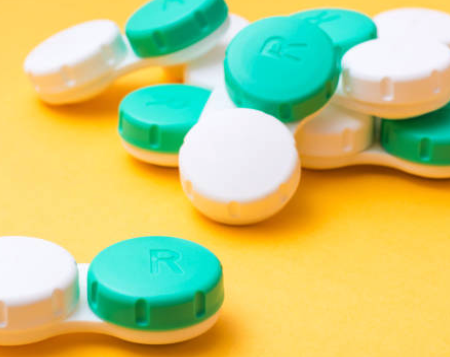Storing your contact lenses in a dirty case is downright gross. It’s kind of like not washing your toothbrush holder often enough and discovering yucky green muck at the bottom. Like petri dishes, both receptacles can harbor millions of bacteria and germs and make you sick. But placing a device in your eye that is potentially crawling with harmful bacteria can result in even more frightening results than brushing your teeth with a dirty toothbrush. Instead of improving your vision, dirty contacts can cause bacterial or fungal eye infections, some of which can permanently damage your eyesight. So today is the day to clean up your daily contact lens routine!
Contact Lenses Cleaner Facts
You are in good company if you reuse your cleaning and storage solution — it’s a common habit you and everyone else needs to break. The minor savings you might realize are hardly worth risking an eye infection. Here are five things you need to know about contact lens solutions.
- Throw out your old solution and start with fresh solution daily
- Choose a hydrogen peroxide-based solution to reduce bacteria
- Don’t put the solution directly into your eye
- Don’t rinse the lenses without the proper supplied case
- Fill the case wells to the top with the fresh solution so the lenses are completely covered
Replace the Case Often
The American Optometric Association recommends replacing contact lens storage cases at least once every three months, while contact lens solution manufacturers typically recommend replacement every one to three months.
How to Clean Contact Lens Case
Just because you don’t see the same yucky green muck in the case as your toothbrush holder doesn’t mean it’s clean. Bacteria forms biofilm you can’t see with the naked eye, but those nasty little microorganisms in the case can wreak havoc on your vision. Here are seven important things to keep in mind when cleaning your contact lens case.
- Wash your hands with soap and water before handling your case
- Right after removing your lenses, empty all the old solution from the wells of the case
- Rinse the case with clean contact lens disinfecting solution
- Rub the case with clean fingers for at least five seconds
- Wipe case dry with a clean tissue
- Air dry the case face down on a tissue with the caps off in a clean, dry location (never the bathroom)
- If your case has silver nitrate lining, feel free to leave keep the caps on
Never wash your case with tap water. This increases the risk of Acanthamoeba keratitis, a rare but severe corneal infection that can lead to permanent vision loss. Signs include eye pain, redness, blurry vision, the sensation that you have something in your eye, sensitivity to light, and excessive tearing.
Following a few easy precautions a day is the best way to protect your investment and your eyesight!
Subscribe to our email newsletter to get the latest posts delivered right to your email.

